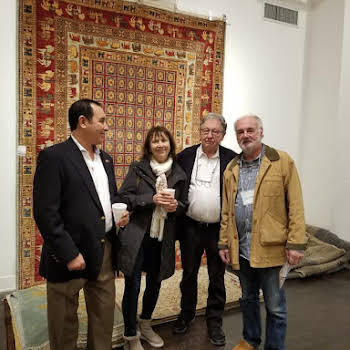WHY AZ?
As mentioned in “Rug Types and AZ’s Insight,” most of our new rugs are the “reproductions” of antique rugs from Afghanistan. It’s the continuation of our one-hundred-year-old family business and decades-old Afghan Rug Project. These are entirely hand-made, mostly from hand-spun wool dyed by natural dyestuffs (there is no rug making factory in Afghanistan).
Afghan rugs have been the award winner for the past 3 decades for their quality and look worldwide.
Tribal Afghan Rugs:
A Timeless Blend of Artistry and Craftsmanship
Discover the allure of Afghan rugs – exquisite handwoven masterpieces. This comprehensive article explores the rich history, unique designs, and craftsmanship behind these iconic floor coverings. Learn about the cultural significance and where to find the best Afghan rugs for your home.
Exploring Different Tribal & Afghan Rugs
Tribal rugs have been prized for centuries for their unparalleled artistry and craftsmanship. These handwoven masterpieces reflect the rich cultural heritage and deep-rooted traditions of regions that stretch beyond geographical borders. In this comprehensive article, we delve into the fascinating world of Tribal rugs, exploring their history, intricate designs, and the dedicated artisans who bring them to life. Whether you’re a connoisseur of fine carpets or simply interested in learning about this exquisite art form, join us as we unravel the beauty and complexity of Tribal rugs.
Afghan and Tribal Rugs: A Legacy of Beauty and Culture
Afghan or Tribal rugs, also known as Afghan/Tribal carpets, have been a symbol of Tribal culture and heritage for generations. Their history dates back over two millennia, with records of carpet-making dating as far back as the 5th century BCE. These rugs are deeply intertwined with the country’s identity and have played a significant role in various aspects of Afghan life.
1. Ancient Origins and Influences
The roots of Afghan rug-making can be traced back to the nomadic tribes of Central Asia, who settled in the region and brought their weaving traditions with them. Over the centuries, the art of rug-making in Afghanistan was influenced by various civilizations, including Persians, Greeks, and Chinese, resulting in a unique and diverse blend of styles.
2. Distinctive Features and Designs
One of the hallmarks of Afghan rugs is their bold and intricate designs. These designs often feature geometric patterns, floral motifs, and medallion layouts. Each region in Afghanistan has its distinct design characteristics, making Afghan rugs a diverse and captivating art form.
3. Superior Craftsmanship
The craftsmanship behind Afghan rugs is nothing short of extraordinary. Artisans, often working in small villages or nomadic communities, meticulously weave each rug by hand, using traditional techniques passed down through generations. The process involves great skill and patience, with some larger rugs taking months or even years to complete.
4. Materials and Dyes
The choice of materials and dyes used in Afghan rug-making is of paramount importance. High-quality wool, silk, and cotton are the primary materials, ensuring the rugs’ durability and luxurious feel. Natural dyes derived from plants, minerals, and insects are preferred, giving Afghan rugs their rich and vibrant colors.
5. Cultural Significance
Tribal rugs are deeply ingrained in the social fabric of Tribal society. They play a central role in important life events, such as weddings and other ceremonies. These rugs are often considered prized possessions, passed down as family heirlooms from one generation to the next.
The Beauty of Tribal Rugs in Modern Times
Despite the passage of time, Tribal rugs continue to hold a special place in the world of interior design and art. Their timeless appeal and undeniable beauty have garnered international recognition, making them highly sought after in the global market.
- International Appreciation
- Decorating with One-Of-A-Kind Tribal Rugs
- Investment Value
- Ethical and Sustainable Production
- Promoting Cultural Heritage
Care and Maintenance of Tribal Rugs (See our Service)
Owning a Tribal rug is a commitment to preserving its beauty for years. Proper care and maintenance are essential to ensure these cherished rugs stand the test of time.
- Regular Cleaning and Vacuuming
- Spot Cleaning and Stain Removal
- Professional Cleaning
- Rotate Your Rug Regularly
- Protect from Sunlight
To protect its vibrancy, consider using curtains or blinds to shield the rug from harsh sunlight.
Are All Tribal and Afghan Rugs Made from Wool?
Yes, most Afghan rugs are made from wool. The wool comes from the sheep that graze on the high plateaus of Afghanistan, resulting in a high-quality, durable, and soft material for rug-making.
How Do I Know if an Afghan Rug is Authentic?
Authentic Afghan rugs often carry distinct design elements that are characteristic of specific regions in Afghanistan. Additionally, they are usually handmade, and their intricate details and irregularities are evidence of genuine craftsmanship.
Can I Use Afghan Rugs in High-traffic Areas?
Absolutely! Afghan rugs are known for their durability and resilience, making them ideal for high-traffic areas. However, rotating the rug periodically can help maintain its appearance and prolong its life.
How Can I Support Afghan Rug Artisans and Communities?
By purchasing authentic Afghan rugs from reputable sources that support fair trade practices, you contribute to the livelihoods of the artisans and help preserve the ancient tradition of rug-making in Afghanistan.
Our three-hundred-family rug project in northern Afghanistan supports weavers, primarily women.

 Alex with Paula, James Opie & Larry Simon
Alex with Paula, James Opie & Larry Simon


